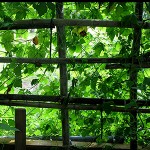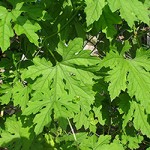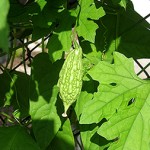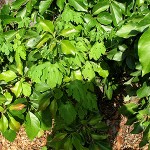In The Garden: Growing Bitter Melon
- Wild Plant Related To Bitter Melon
- Bitter Melon
- Bitter Melon Gourd
- Bitter Melon Growing on Avocado Tree
In previous posts I have mentioned growing bitter melon in the garden. For many years I have enjoyed eating this unusual asian bitter gourd.
While working in Chinese restaurants I had the good fortune to eat food that Chinese chefs do not make for their American clientele. Each day the chef made something traditional for the staff to eat. Sometimes it was as simple as a can of fried dace with black beans and a plate of gai lon and rice, other times the meal was something special like a rich duck stew with fresh (not canned) bamboo shoots, or thousand year old eggs, or winter melon soup. I discovered so many vegetables and so many flavors I had never before experienced at the table. It was a real culinary pleasure. Bitter Melon was one such discovery.
Bitter melon or bitter gourd is a cucurbit, a plant from the family Cucurbitaceae. It is a vegetable that grows well in hot and humid weather so it is a natural for our summer months. It has deeply lobed palmate leaves and tiny tendrils that wrap around the fence or trellis on which it grows. It has yellow flowers and a green gourd that has a lobed and lumpy surface. Inside the seeds are coated in something red and slimy. I have never eaten the seeds, and they were never offered so I think they are not edible. As it ripens the gourd turns orange. I have always eaten it while the color is still green. I harvest once I see any orange color. There are many different varieties of bitter gourd and it is eaten throughout various asian cultures in myriad ways. I have only had it prepared in two different ways; stir fried in a salty sauce with meat, and stuffed with ground meat. At home I stir fry it in black bean garlic sauce.
Bitter Melon is as its name implies, bitter. I recall that whenever it is discussed inevitably its health benefits are mentioned. I have been told it is good for digestion. Really I am glad it is a healthy vegetable, but I eat it because I love the bitter flavor. It tastes wonderful teamed up with a salty sauce.
The first time I grew Bitter Melon I was surprised to discover that it looks exactly like a weed that grows here. I believe they are close relatives. That smelly weed which I often pull out of trees has the same shaped leaves, the same tendrils, the same growth habit, the same yellow flowers, the same smell, and this weed has a small seed pod that also turns orange and once ripe it splits open to disperse seeds covered in some slimy red coating. Two separate friends, one who keeps iguanas, and one who keeps chickens have mentioned to me that their creatures eat that weed when they are ill and allowed to forage. I am wondering if that weed has some food or medicinal value for us too.
Bitter Melon is often sold in oriental food markets. To cook it you slice it open and remove the seeds and junk inside. Cut it into bite sized pieces and stir fry in black bean garlic sauce. Black Bean Garlic Sauce is usually sold in concentrated form in a jar. Just one heaping teaspoon mixed with some cooking oil (peanut or sesame if you want an authentic oriental vibe), and water will flavor the bitter melon when stir fried all together. It is usually cooked just long enough to soften it a little. Once it softens the edges take on some of the color of the brown sauce, I just poke it with a fork to be sure.
Growing Bitter Melon here in South Florida requires good soil made with ample compost, regular watering, and a good support system for climbing, as well as good mulch (I use straw) to retain moisture in the soil. I find that since I am growing it in our hottest weather the Bitter Melon plant starts well in partial shade, and then seeks the sun as it grows up.
While this is one of my favorites vegetables it is quite bitter and has no match I can think of in traditional American cuisine.
Unless you are very adventurous, or commonly enjoy bitter flavors this bitter melon may not appeal to you. Then again, I love bitter melon, and you may too. If you grow bitter melon your friendly neighborhood Chinese food restaurant may want to buy some of your harvest. After all employee meal happens every day.
Cheers to different flavors!





17 Responses
You’ve made me curious to try it!!
Right on Sara, thanks for your comment.
Cool! I love new vegetables — to to try this one!
Thanks for your comment Dorothy. I hope you like it.
I knew of bitter melon as I had seen it in oriental stores but never tried it.last month a friend of mine from honduras told me she had cured her high cholesterol a nd normalized her blood sugar(she is diabetic) in 6 weeks. Since I have the same health issues she told me what to do. She made a strong tea by boiling a weed from her garden fence. She called this weed calaica Since she is still very much alive, I decided to try after searching on the net. I do have this stink weed in my yard also. It looks exactly like the bitter melon plant. And so I can verify that this weed does have medicinal properties like the bitter melon. It puts out what looks like a little lantern fruit that ripens red.. Now I spend my time looking for this weed and drying it for winter tea but will also start eating bitter melon. The weed we both have must be a close relative to bitter melon
Hi Anne, Thanks for your comment. You are right, lots of island people know about the tea you made from this “stinky weed” plant. Jamaicans call it Cerasee which is good enough for me. Inside that little orange lantern shaped fruit are seeds coated in a bright red slimy substance. Since writing this article I have discovered that the slimy red substance on the seeds is absolutely delicious. It is sweet and so we call it garden candy. My chickens love to eat the leaves of this plant and so I make sure they get a few feet of vines every day. It is a shame so many people try to remove this useful wild plant from their properties.
Ok so…what part do we dry to make tea??? We r trying the slime on the seeds now…yummm…Please advise as I allowing this to grow wild in my yard and wish to harvest inteligently!
Thank you!
Hi Alison, I have heard from a Jamaican friend that her family used the leaves to make tea. When I make teas from leaves I just stuff a few leaves into a tea ball and steap it in just boiled water. I have also read that people use the flowers to make the cerasee tea, and those flowers smell sweet in the morning, so it might be less biter.
I advise caution since I am not well versed in herbal medicine. Remember, just because it comes from a plant you can harvest doesn’t mean you can’t poison yourself with it. Here is a link I found that might be helpful to you in your reading about this plant and it curative properties. https://www.facebook.com/topic.php?uid=139613841820&topic=19322
Where can I get them in Orlando FL?
Hi Fabiola. Y’all can grow it there in Orlando, or if you want to buy the fruit look for it in an Asian grocery store.
Oh wow, cool……funny I just came from an Asian store yesterday saw the plant, lol. I’m curious about the leaves. This may sound strange, but I really want to know where can I get the leaves from. Whose fence can I go to so I can get some leaves & boil them for tea, lol?
oh okay Fabiola, sorry to have misunderstood. Well it grows here in zone 9b everywhere. People think it is a weed and they jerk it out of the ground. You can definitely use the leaves of the wild plant as well as the leaves of the cultivated bitter melon. Check for it on sunny fences, and going up untended landscapes. If all else fails ask your Jamaican friends if they have seen any wild cerasee. Although it burns down in temps below 40 it is likely to come back from seed when the temperatures rise. I hope this helps you.
Yes indeed. Thanks a bunch 🙂
Hello! This plant I think I know under the name of Calaica, and I’m trying to find or buy one, by any chance do you sell some of then? I’m in Houston tx area, or if you know where can I find it? I been in different Chinesse market and not of then have it
Hi Tania, Yes the plant does go by the name Calaica, but that may be the more wild version that is called Cerasee in Jamaica. If you can’t find this bitter melon vegetable in the chinese stores check the other various Asian stores. It is called Ampalaya in the Filipines, and it is used in Indian cooking as well. I am sorry I don’t sell my vegetables often and never by mail.
In India, it is known as ‘Karela’ and is one of the wonder-vegetables with excellent benefits for diabetics and compromised immunity. Its juice is known all over for its numerous benefits. In traditional Indian medicine, Ayurveda and culinary history, Bitter Gourd has pride of place.
Also, a favourite with kitchen gardeners.
Thank you Aman. It is good to hear about how Karela or Bitter Melon figures in the food/medicine culture in India. It is just another example of the excellent useful and healthful vegetables that we can grow in South Florida in the summer, and one of many that we learn about from the tropical and sub tropical growers of the world. It is also an extremely hardy plant to grow having few insect or disease problems in the garden. It is a seed that when planted guarantees a bountiful harvest.